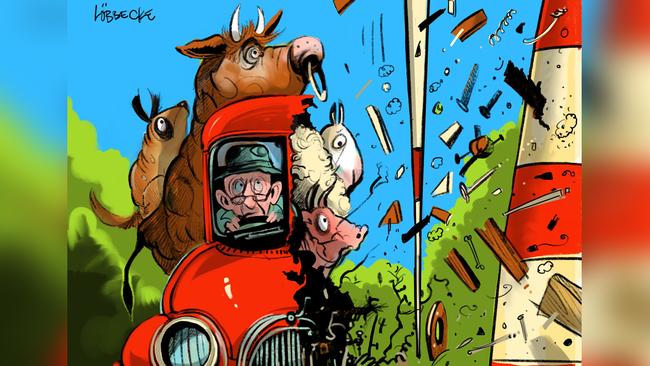Emissions target set to devastate agriculture and transport sectors

When it comes to serious public scrutiny, no policy area has been more overlooked than the economic impact of Australia’s 2030 climate targets. While there has been plenty of debate about policy settings for the electricity sector, there has been no meaningful discussion about the implications of emissions targets for those parts of the economy that produce two-thirds of our CO2 emissions.
Australia is slouching towards an economic shock of historic proportions. In 2005, Australia generated 597 million tonnes of CO2 emissions. The Coalition government has committed to reduce this annual carbon footprint by 26 per cent to 442 million tonnes by 2030. Labor has pledged a 45 per cent reduction to 328 million tonnes. In other words, the difference between the two parties’ climate targets is substantial, 114 million tonnes annually by 2030. To put that into context, the difference between the two parties’ targets is equivalent to the emissions from the entire red meat, dairy, trucking, domestic aviation, rail and bus sectors combined. More than a million Australians owe their livelihoods to these sectors.
Meeting the 2030 targets, especially Labor’s, will be extremely difficult. In the 12 years since 2005, Australia’s emissions have fallen by 43 million tonnes to 554 million tonnes. That reduction is overwhelmingly due to a one-off contribution from new restrictions on land clearing, meaning the economic burden has been borne largely by regional Australia. Emissions from all other sectors have been flat or growing.
So how are we going to get from an annual carbon footprint of 554 million tonnes to the Coalition target (442 million tonnes) or the Labor target (328 million tonnes) by 2030? The widespread assumption is “transition” in our electricity generation will do the trick. But that assumption is based on a big fat misconception. I suspect many people in Australia believe most CO2 emissions come from electricity generation. But electricity accounts for just a third.
If Australia is to meet the ambitious targets the burden will be borne far beyond the electricity sector. And it won’t be pretty.
In Labor’s case, the iron law of arithmetic dictates it is not possible to reduce overall national emissions by 45 per cent by focusing only on the sector that produces one-third of those emissions. Where will the remaining saving come from? They come from activities that feed you, employ you, keep you healthy or move you around. Almost half of non-electricity emissions come from agriculture and transport.
Put simply, it will not be possible to meet Labor’s target without a major impact on agriculture and transport. Tim Flannery acknowledged this on October 3 when he told ABC radio: “We need to have an economy-wide transition. We need to look at transport. We need to be looking at agriculture.”
Labor will argue that deeper cuts in electricity emissions will at least mean other sectors won’t have a 45 per cent cut in emissions. But even if we make the heroic assumption that Labor can reduce emissions in the electricity sector by, say, 55 per cent, it still must find a 35 per cent cut in other sectors, including transport and agriculture. The implications for the farm sector are dire.
About 75 per cent of agriculture emissions come from enteric fermentation (such as burping) by livestock. The only way to reduce agriculture emissions is to cut the national herd. I am certain that Labor has not explained this to the national farming community and regional Australia more generally. Less beef, less lamb, less pork, less milk, less cheese. Fewer farmers and graziers. Fewer manufacturing and food processing jobs. Lower living standards. To give you a sense of what a 35 per cent cut in agricultural emissions would look like, it implies the elimination of the entire sheep meat and dairy sectors.
The story is similar in transport. What does a 35 per cent reduction in transport-related emissions look like? In indicative terms, such a cut implies taking half the cars off the road and the elimination of domestic aviation.
The adoption of reckless 2030 emissions reduction targets has not been accompanied by appropriate critical scrutiny. Few Australians are aware of the economic train wreck that is coming, especially if Labor’s target is adopted. It doesn’t add up. The pretence has gone on too long. To date, Labor and the Greens have pretended that a closure of a few coal-fired power plants will be enough. But big emissions cuts mean major economic damage far beyond the electricity sector. No sector will be spared. And the farm sector and regional Australia are going to be hit hardest.
Ron Boswell is a former Nationals senator for Queensland and former Nationals leader in the Senate.


